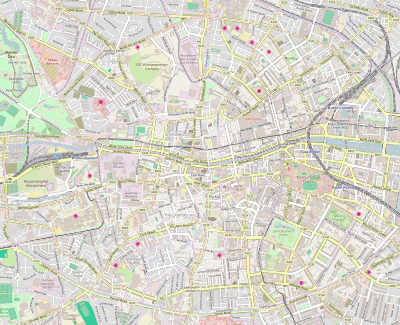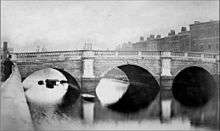O'Connell Bridge
O'Connell Bridge (Irish: Droichead Uí Chonaill)[2] is a road bridge spanning the River Liffey in Dublin, and joining O'Connell Street to D'Olier Street, Westmoreland Street and the south quays.
O'Connell Bridge Droichead Uí Chonaill | |
|---|---|
 O'Connell Bridge viewed from upstream | |
| Coordinates | 53.3473°N 6.2591°W |
| Crosses | River Liffey |
| Locale | Dublin |
| Other name(s) | Carlisle Bridge |
| Characteristics | |
| Material | Granite, portland stone |
| Total length | ~45m |
| Width | ~50m (~47m between parapets[1]) |
| No. of spans | 3 |
| History | |
| Designer | James Gandon |
| Construction start | 1791 (reconstruction commenced 1877) |
| Construction end | 1794 (reconstruction completed 1882) |
 O'Connell Bridge Location in Central Dublin | |
History
The original bridge (named Carlisle Bridge for the then Lord Lieutenant of Ireland – Frederick Howard, 5th Earl of Carlisle) was designed by James Gandon, and built between 1791 and 1794.[3]
Originally humped,[3] and narrower, Carlisle bridge was a symmetrical, three semicircular arch structure constructed in granite with a Portland stone balustrade and obelisks on each of the four corners.[4] A keystone head at the apex of the central span symbolises the River Liffey, corresponding to the heads on the Custom House (also designed by James Gandon) which personify the other great rivers of Ireland.
.jpg)
Since 1860, (following similar work on Essex Bridge – now Grattan Bridge), to improve the streetscape and relieve traffic congestion on the bridge, it was intended to widen Carlisle Bridge to bring it to the same width as 70 metres (230 ft) wide Sackville Street (now O'Connell Street) which formed the north side carriageway connection to the Bridge.[4] Between 1877 and 1880 the bridge was reconstructed and widened.[5] As can be seen on orthophotography [6] it spans now 45 m of the Liffey and is about 50 m wide.
When the bridge was reopened c.1882 it was renamed for Daniel O'Connell when the statue in his honour was unveiled.[lower-alpha 1]
In recent years, the lamps that graced the central island have been restored to their five lantern glory. In 2004, a pair of pranksters installed a plaque on the bridge dedicated to Father Pat Noise, which remained unnoticed until May 2006,[8] and was still there as of June 2020.

In popular culture
The bridge is the setting of Liam O'Flaherty's short story, The Sniper, and is also referenced in several other works, including James Joyce's novel, Ulysses.[9]
Arthur Fields, locally known as The Man on The Bridge, took more than 182,000 photographs of pedestrians on the bridge from the 1930s to the 1980s.[10][11]
Notes
- There are actually two O'Connell bridges in Dublin. The other spans the pond in St Stephen's Green.[7]
References
- Ronald C. Cox, Michael H. Gould (1998). Ireland – Civil Engineering Heritage. Telford. p. 41. ISBN 9780727726278.
the width between parapets [is] 152 ft 8 in [approx 47m]
CS1 maint: uses authors parameter (link) - "Droichead Uí Chonaill / O'Connell Bridge". Placenames Commission Database. Logainm.ie. Retrieved 9 December 2016.
- "1880 – O'Connell Bridge, Dublin". Architecture of Dublin City. Archiseek.com. 2010.
- Project history of Dublin's River Liffey bridges (PDF). Bridge Engineering 156 Issue BE4 (Report). Phillips & Hamilton. Archived from the original (PDF) on 2017-08-12. Retrieved 2005-06-14.
- O'Connell Bridge at Structurae. Retrieved 9 December 2016.
- "Shop.osi.ie mapviewer". Ordnance Survey Ireland. Archived from the original on 2010-05-29. Retrieved 2009-12-12.
- "O'Connell Bridge - Overview". Bridges of Dublin. Dublin City Council. Retrieved 13 May 2020.
- "The Father Pat Noise 'Memorial'". Blather.net. 16 May 2006.
- "Dubliners could get their big bronze 'time ball' back". theirishtimes.com. Irish Times. 4 October 2017. Retrieved 13 May 2020.
- "Arthur Fields: the man on O'Connell bridge". The Guardian. 18 August 2013.
- "Man on Bridge – Photos on the bridge from 1930s–1980s". ManOnBridge.ie. Retrieved 9 December 2016.
| Wikimedia Commons has media related to O'Connell Bridge. |